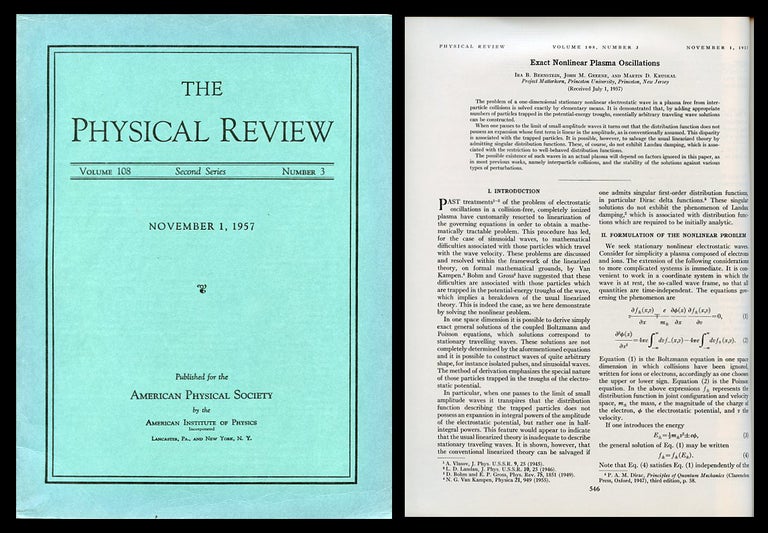Exact Nonlinear Plasma Oscillations in Physical Review 108, 3, pp. 546-551, 1 November 1957
New York: American Physical Society, 1957. 1st Edition. FIRST EDITION IN ORIGINAL WRAPS OF THE BERNSTEIN-GREENE-KRUSKAL (BGK) MODE, AMONG THE MOST FUNDAMENTAL CONCEPTS IN PLASMA PHYSICS. Also included: D. L. Dexter's "Possibility of Luminescent Quantum Yields Greater than Unity" (pp. 630-634). First appearance of the idea of quantum cutting (also known as photon cascade emission or quantum cascade emission). The term "describes the phenomenon where the energy of one absorbed photon is transformed into two or more emitted photons" (Fan, JPC, 116, 21, 2012, 11652).
"In plasma physics, the nonlinear wave-particle interactions between particles and waves can give rise to phase-space holes', which are large-amplitude solitary potential structures with trapped-particle populations. First indications of the possibility of such strange entities were obtained by Bernstein et al. [in this paper], who found that potential structures of arbitrarily large amplitude could be constructed in a plasma if trapped-particle populations could be specified. These nonlinear solutions have become known as BGK equilibria or BGK" (Paschmann, Auroral Plasma Physics, 89).
The paper shows "that equilibrium solutions to the time-independent Vlasov-Poisson equations can be constructed if the velocity distribution functions of electrons and ions are expressed as functions of the Hamiltonian, i.e., the sum of kinetic energy and electrostatic potential energy. The physical model considered in the paper is one-dimensional with variation along the static magnetic field" (Meyer-Vernet, Physics of Space, 45). The authors also discuss existent potential structures such as bumps and dents that trap some electrons and ions. The equilibrium solution in such a collision less plasma has generally been called as a BGK mode after the three authors of the paper. However [at the time] there was no recognition that BGK modes can really exist in space plasmas.
"Ten years later, it was demonstrated by a computer simulation that there appears a solitary BGK mode after nonlinear evolution of an instability induced by two counter streaming electron beams" (ibid). Item #1007
CONDITION & DETAILS: First edition in original wraps. New York: The American Physical Society. 4to (10.5 x 7.5 inches; 256 x 188mm). Pp. 507-909. Very slight scuffing at the spine tips. Exceptionally and clean inside and out. Fine condition.
Price: $200.00

